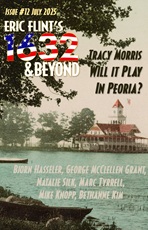 Eric Flint’s 1632 & Beyond #12, July/August 2025
Eric Flint’s 1632 & Beyond #12, July/August 2025
“Chautauqua, Disney, and the World’s Fair” by Bjorn Hasseler
“But Will It Play in Peoria?” by Tracy S. Morris
“Renamed” by Bethanne Kim
“Escaping the What-Ifs” by Michael Knopp
“A Flask and a Handshake” by Natalie Silk
“That Old Chestnut” by George McClellan Grant
“To Kill a Redbird” by Marc Tyrrell
Reviewed by Victoria Silverwolf
[Editor’s note: The following is offered by Tangent reviewer Mike Bickerdike as a guide for those not familiar with this magazine’s concept.] Eric Flint’s 1632 & Beyond is a magazine comprising stories set in the late Eric Flint’s “Ring of Fire” or 1632 alternate-history universe. For those unfamiliar with the books, the essential concept is that the town of Grantville in West Virginia became transported (by cosmic accident) from our present day to northern Germany in 1632 during the 30 Years War. The book series extends to dozens of novels. The short stories in this magazine are set within that framework.
All the stories in this issue involve the Redbird Institute, a large project combining exhibits, lectures, lodging, dining, entertainment, and recreation. The motive is to introduce ideas and technology from the future to the people in the past. The magazine offers a lengthy introduction to the institute, along with a map.
The title of “Chautauqua, Disney, and the World’s Fair” by Bjorn Hasseler provides the reader with metaphors for the institute’s many aspects. The story deals with the beginning of the project, from the initial idea to the nuts and bolts of bringing it to life.
The amount of detail that went into creating the concept of the institute is impressive, but there is little plot. This work reads more like background notes for a roleplaying game than a fully developed tale.
“But Will It Play in Peoria?” by Tracy S. Morris deals with a small test run of the institute in the town of Grantville. A newspaper reporter and a private investigator become involved with attempts to sabotage the project before it can reach its full potential.
This is a broad comedy, with a wisecracking girl reporter and an inept private eye straight out of an old black-and-white movie. The presence of teenagers dancing to big band music and 1950’s rock ‘n’ roll adds to the feeling of nostalgia. Readers looking for very light amusement are likely to enjoy it, while others may find it too silly.
“Renamed” by Bethanne Kim deals with a group of young people, analogous to Boy Scouts and Girl Scouts, constructing an outdoor amphitheater for the institute. The title refers to a subplot in which a character changes his name.
There is not much excitement to this slice-of-life. The characters are pleasant, but the plot lacks conflict and suspense.
In “Escaping the What-Ifs” by Michael Knopp, an engineer working on a project to bring a steam locomotive to the institute witnesses an explosion that kills his assistant. He suffers from feelings of guilt until advice from a man who has experienced his own tragedy inspires him to help develop a safer means of transportation.
This is a sensitive, introspective story that treats survivor’s guilt in a mature fashion. It discusses the human costs of technological advancement in an honest way.
In “A Flask and a Handshake” by Natalie Silk, a man journeys to the institute with the intention of selling orange juice. He travels with his young son, who is fascinated by flying machines.
The premise sets up the conflict between the father, who wants his son to go into the family business, and the boy, who wants to be a pilot. This is left unresolved, and the story ends abruptly.
“The Old Chestnut” by George McClellan Grant is narrated by a chestnut tree, killed by the chestnut blight brought from the future. It relates how its wood was used to construct part of the institute’s lodge.
The choice of narrator is certainly unique. Those who are interested in the techniques used to build a large wooden structure will find this nearly plotless story more to their liking than other readers.
“To Kill a Redbird” by Marc Tyrrell deals with business leaders working to destroy the institute’s reputation because they are opposed to innovations such as labor unions, religious freedom, and democracy. They plot to add a toxic substance to some of the food served at the institution, and even go so far as to hire an assassin. Alerted to the danger, the heroes struggle to prevent the conspirators from triumphing.
Although the story has the structure of a tale of suspense, the good guys are one step ahead of the bad guys from the beginning. The conspirators often take foolish risks, and hire unreliable henchmen. The text offers greatly detailed descriptions of gourmet food and drink, resulting in a work that may appeal more to epicureans than fans of science fiction.
Victoria Silverwolf bought a lot of tuna and salmon for the cats today.